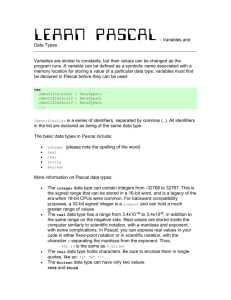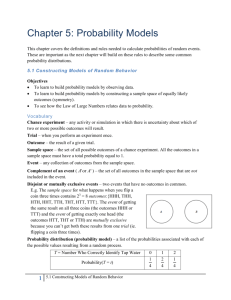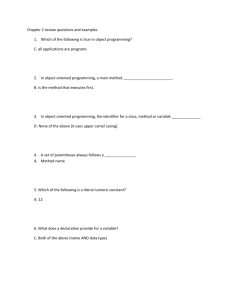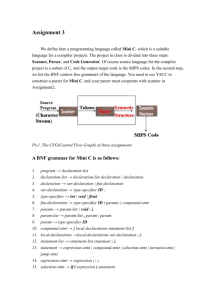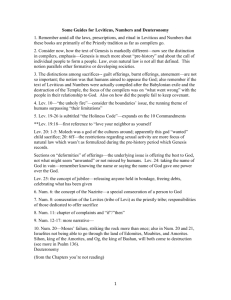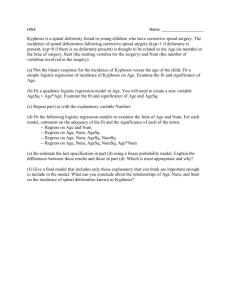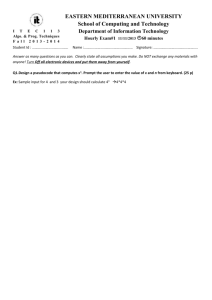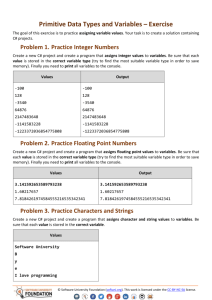REALCNVT A set of conversion routines to convert between various
advertisement
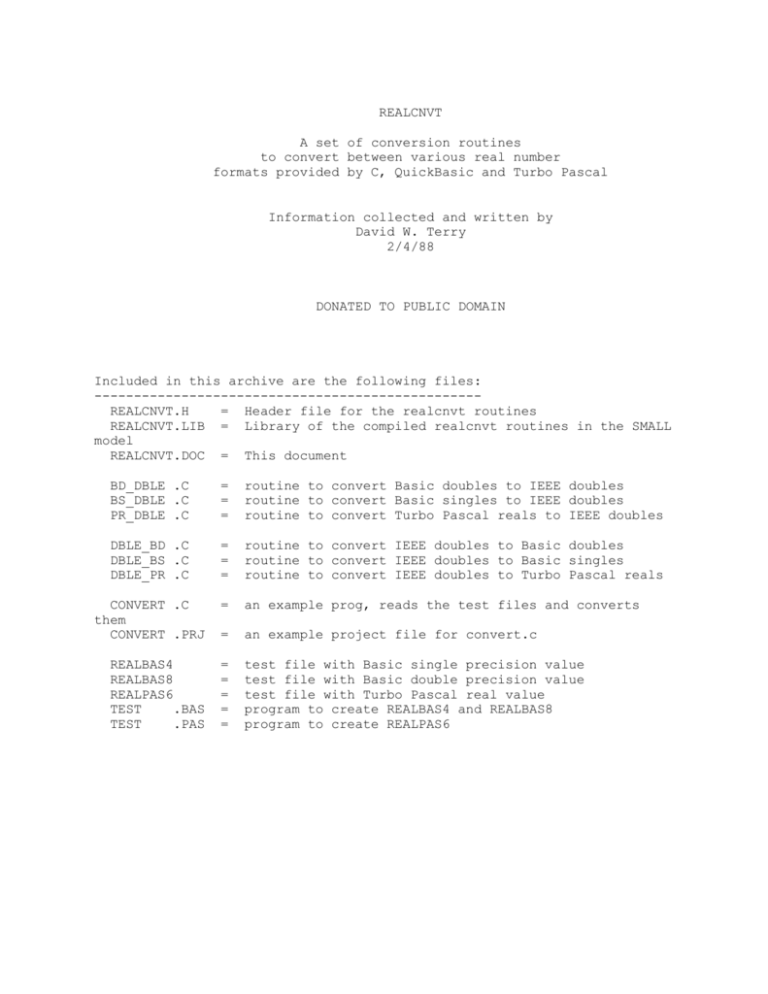
REALCNVT
A set of conversion routines
to convert between various real number
formats provided by C, QuickBasic and Turbo Pascal
Information collected and written by
David W. Terry
2/4/88
DONATED TO PUBLIC DOMAIN
Included in this archive are the following files:
------------------------------------------------REALCNVT.H
= Header file for the realcnvt routines
REALCNVT.LIB = Library of the compiled realcnvt routines in the SMALL
model
REALCNVT.DOC = This document
BD_DBLE .C
BS_DBLE .C
PR_DBLE .C
=
=
=
routine to convert Basic doubles to IEEE doubles
routine to convert Basic singles to IEEE doubles
routine to convert Turbo Pascal reals to IEEE doubles
DBLE_BD .C
DBLE_BS .C
DBLE_PR .C
=
=
=
routine to convert IEEE doubles to Basic doubles
routine to convert IEEE doubles to Basic singles
routine to convert IEEE doubles to Turbo Pascal reals
CONVERT .C
them
CONVERT .PRJ
=
an example prog, reads the test files and converts
=
an example project file for convert.c
REALBAS4
REALBAS8
REALPAS6
TEST
.BAS
TEST
.PAS
=
=
=
=
=
test file with Basic single precision value
test file with Basic double precision value
test file with Turbo Pascal real value
program to create REALBAS4 and REALBAS8
program to create REALPAS6
Routine Usage
------------The header file (REALCNVT.H) includes several typedef definitions that
can aid
in developing your conversions. They are as follows:
pasreal
= typedef unsigned char pasreal[6];
bassngl
= typedef unsigned char bassngl[4];
basdble
= typedef unsigned char basdble[8];
You can use these names as your own data types in your program to read
and
write to your files where necessary. Example:
#include "realcnvt.h"
struct {
pasreal PR;
bassngl BS;
basdble BD;
} mystruct;
With "mystruct" you could read and write records to a file that consist
of all
three types of real numbers at once. While the variables PR, BS and BD
are
essentially "un-readable" by the standard C library, you can link your
program
together with the REALCNVT.LIB (or the actual object files if you compile
them
yourself) and then use the conversion routines to convert between each of
the
variables and the IEEE real format (8-byte doubles).
The conversion routines provided are as follows:
double pasrealtodouble(pasreal OldNum);
--------------------------------------Converts a Turbo Pascal Real to an IEEE Double.
of
type "pasreal" and it returns a double.
Example:
pasreal oldvalue;
You pass it a variable
double
newvalue;
newvalue = pasrealtodouble( oldvalue );
double bassngltodouble(bassngl OldNum);
--------------------------------------Converts a Basic Single to an IEEE Double.
type
"bassngl" and it returns a double.
Example:
You pass it a variable of
bassngl oldvalue;
double newvalue;
newvalue = bassngltodouble( oldvalue );
double basdbletodouble(basdble OldNum);
--------------------------------------Converts a Basic Double to an IEEE Double.
type
"basdble" and it returns a double.
Example:
You pass it a variable of
basdble oldvalue;
double newvalue;
newvalue = basdbletodouble( oldvalue );
void doubletopasreal(pasreal *New, double Old);
----------------------------------------------Converts an IEEE Double to a Turbo Pascal Real. You pass it a POINTER to
a
variable of type "pasreal" and the value of the Double to convert.
Example:
pasreal newvalue;
double oldvalue;
doubletopasreal( &newvalue, oldvalue );
void doubletobassngl(bassngl *New, double Old);
----------------------------------------------Converts an IEEE Double to a Basic Single. You pass it a POINTER to a
variable of type "bassngl" and the value of the Double to convert.
Example:
bassngl newvalue;
double oldvalue;
doubletobassngl( &newvalue, oldvalue );
void doubletobasdble(basdble *New, double Old);
----------------------------------------------Converts an IEEE Double to a Basic Double. You pass it a POINTER to a
variable of type "basdble" and the value of the Double to convert.
Example:
basdble newvalue;
double
oldvalue;
doubletobasdble( &newvalue, oldvalue );
See the file CONVERT.C for a more complete example of the above routines.
The following are simplified diagrams of the storage formats for each of
the
real formats discussed in these conversion routines.
IEEE 8-byte real format
----------------------[0] - num
[1] - num
[2] - num
[3] - num
[4] - num
[5] - num
[6] - num plus \ 4 bits of exponent
[7] / 7 bits of exponent, 8th bit is the sign
Turbo Pascal 6-byte real format
------------------------------[0] - exponent
[1] - num
[2] - num
[3] - num
[4] - num
[5] - num with Sign at 8th bit
Basic Single 4-byte real format
------------------------------[0] - num
[1] - num
[2] - num with Sign at 8th bit
[3] - exponent
Basic Double 8-byte real format
------------------------------[0] - num
[1] - num
[2] - num
[3] - num
[4] - num
[5] - num
[6] - num with Sign at 8th bit
[7] - exponent
-----------------------------------------------------------------------------The following information has been added to help those that are
converting
the basic real values to variables usable by Turbo Pascal.
Date: 04-10-95 (17:08)
To: MARIO MUELLER
From: DAVID TERRY
Subj: BASIC SINGLE (4-BYTE REAL
Read: NO
(Echo)
Conf: RIME PCBoard Support (37)
Number: 46405 of 46405 (Refer# 46397)
Status: PUBLIC MESSAGE
Read Type: GENERAL (+)
-> What I was looking for was, I guess, code that will convert the BASIC
Single
-> 4-Byte reals that are used in PCBoard's MSGS.* files to Pascal 6-Byte
Reals
-> (since Pascal's Single doesn't seem to work) ... OR something that
allows me
-> to read them through Pascal normally.
If you look at the REALCNVT.DOC you'll get a hint as to what you can do
(I'm
afraid I can't write the code for you). I'm refering to these two items:
Turbo Pascal 6-byte real format
------------------------------[0] - exponent
[1] - num5
[2] - num4
[3] - num3
[4] - num2
[5] - num1 with Sign at 8th bit
Basic Single 4-byte real format
------------------------------[0] - num3
[1] - num2
[2] - num1 with Sign at 8th bit
[3] - exponent
If you look at the byte layout, it becomes obvious that all you really
have to
do is move the bytes around to make a conversion between the two formats.
In other words, take the byte at offset 3 from the basic number, and put
it
into offset 0 of the pascal number. Fill bytes at offsets 1 and 2 in the
pascal number with 0's. Then copy the bytes from offsets 0-2 out of the
basic
number into the bytes at offsets 3-5 in the pascal number.
I've modified the above illustration just slightly to help make the point
clearer. In REALCNVT.DOC it just uses the word "num", but up above I
have
numbered them (num1, num2, num3, etc). By looking at the bytes that way,
you
can see which ones go where when you copy them across.
For the 8-byte basic real number, the same technique works except,
instead of
filling pascal bytes num4 and num5 with zeroes, you'll copy all of 5 of
them
from the basic value, and then simply ignore the bytes at offsets 0 and 1
(num6
and num7 in the illustration below):
Turbo Pascal 6-byte real format
------------------------------[0] - exponent
[1] - num5
[2] - num4
[3] - num3
[4] - num2
[5] - num1 with Sign at 8th bit
Basic Double 8-byte real format
------------------------------[0] - num7
[1] - num6
[2] - num5
[3] - num4
[4] - num3
[5] - num2
[6] - num1 with Sign at 8th bit
[7] - exponent
To convert back the other direction, you just copy the bytes in the
opposite
direction and fill (or ignore) bytes as appropriate.

